
Pautas de la OSHA sobre límites de exposición al ruido
INFORMACIÓN DE CONFORMIDAD EN LA UNIÓN EUROPEA
(EUROPEAN UNION, EU)
Tiene derecho a llevar la marca CE; satisface la directiva de bajo voltaje 2006/95/
EC de la Unión Europea; la directiva de EMC 2004/108/EC de la Unión Europea; la
directiva de Restricción de Sustancias Peligrosas (Restriction of Hazardous Substances,
RoHS) 2002/95/EC de la Unión Europea; la directiva de Desechos de Equipo Eléctrico
y Electrónico (DEEE) (Waste Electrical and Electronic Equipment, WEEE) 2002/96/EC
de la Unión Europea y la directiva de Registro, Evaluación y Autorización de Sustancias y
Preparados Químicos (Registration, Evaluation and Authorization of Chemicals, REACH)
2006/121/EC de la Unión Europea.
AVISO DE LA DEEE
Nota: Esta marca se aplica sólo a países de la Unión Europea (European Union, EU)
y Noruega.
Este dispositivo ha sido etiquetado de acuerdo con la directiva europea
2002/96/EC sobre Desechos de Equipo Eléctrico y Electrónico (DEEE)
(Waste Electrical and Electronic Equipment, WEEE). Esta etiqueta indica
que este producto no se debe desechar con desperdicios domésticos.
Se debe dejar en un establecimiento apropiado para su recuperación y
reciclaje.
Image S4 Headphones
OSHA Guidelines for Noise Exposure Limits
EU COMPLIANCE INFORMATION
Eligible to bear the CE mark; Conforms to European Union Low Voltage Directive
2006/95/EC; European Union EMC Directive 2004/108/EC; European Union RoHS
Directive 2002/95/EC; European Union WEEE Directive 2002/96/EC; European Union
Registration, Evaluation, Authorization and Restriction of Chemicals (REACH) Directive
2006/121/EC.
WEEE NOTICE
Note: This mark applies only to countries within the European Union (EU) and Norway.
This appliance is labeled in accordance with European Directive 2002/96/EC
concerning waste electrical and electronic equipment (WEEE). This label indicates that
this product should not be disposed of with household waste. It should be deposited at
an appropriate facility to enable recovery and recycling.
English
Spanish
Sound Pressure Level Recommended Maximum Exposure
Per Day
90dB 8 Hours
92dB 6 Hours
95dB 4 Hours
97dB 3 Hours
100dB 2 Hours
102dB 1.5 Hours
105dB 1 Hours
110dB 30 Minutes
115dB 15 Minutes or less
120dB Avoid as damage may occur
Important Safety Information
1) READ these instructions.
2) KEEP these instructions.
3) HEED all warnings.
4) FOLLOW all these instructions.
5) DO NOT use this apparatus near water or moisture.
6) If you hear ringing or experience pain or discomfort in your ears during or after
using any in-ear audio product, that is a sign you are listening too loud. When
your ears are exposed to high volumes (in excess of 85dB) for over an hour,
you may be permanently damaging your hearing.
7) Turn down your listening device’s volume to zero before you insert the Klipsch
headphones and turn on the device. Once you have the headphones on,
gradually increase the volume to a comfortable, moderate volume.
8) Do not install near any heat sources such as radiators, heat registers, stoves,
or other apparatus (including amplifiers) that produce heat.
9) ONLY USE attachments/accessories specified by the manufacturer.
10) REFER all servicing to qualified service personnel. Servicing is required when
the apparatus has been damaged in any way, such as power-supply cord
or plug is damaged, liquid has been spilled or objects have fallen into the
apparatus, the apparatus has been exposed to rain or moisture, does not
operate normally, or has been dropped
11) NEVER operate a motor vehicle while listening to or wearing your headphones.
Not only dangerous, it is illegal in many places.
12) NEVER operate heavy machinery while listening to or wearing your
headphones.
13) We don’t recommend you use the headphones while riding a bicycle,
running,or walking in heavy traffic areas.
WARNING:
Except in case of emergency, Klipsch recommends you do not use these
headphones or headsets (headphones plus microphone) as aviation communication
equipment as they are not engineered for many environmental conditions common
in commercial or non-commercial aircraft (including, but not limited to: altitude,
temperature, noise conditions, unpressurized aircraft, etc.) resulting in possible
interference to critical communications.
The Occupational Safety Health Administration (OSHA) has issued headphone
usage recommendations for maximum daily exposure and sound pressure levels
(measured in decibels (dB)). A decibel is a unit of measure of sound, and decibels
increase exponentially as sound gets louder. For example, conversational speech
is typically around 60dB, and a rock concert in a stadium is often about 110dB.
FCC AND CANADA EMC COMPLIANCE INFORMATION
NOTE: This equipment has been tested and found to comply with the limits for
a Class B digital device, pursuant to part 15 of the FCC Rules. These limits are
designed to provide reasonable protection against harmful interference in a
residential installation. This equipment generates, uses and can radiate radio
frequency energy and, if not in-stalled and used in accordance with the instructions,
may cause harmful interference to radio communications. However, there is
no guarantee that interference will not occur in a particular installation. If this
equipment does cause harmful interference to radio or television reception, which
can be determined by turning the equipment off and on, the user is encouraged to
try to correct the interference by one or more of the following measures:
•
Reorient or relocate the receiving antenna.
•
Increase the separation between the equipment and receiver.
•
Connect the equipment into an outlet on a circuit different from that to which
the receiver is connected.
•
Consult the dealer or an experienced radio/TV technician for help.
Approved under the verification provision of FCC Part 15 as a Class B Digital Device.
Caution: Changes or modifications not expressly approved by the manufacturer
could void the user’s authority to operate this device.
This Class B digital apparatus complies with Canadian ICES-003.
Cet appareil numérique de la classe B est conforme à la norme NMB-003 du
Canada.
PRODUCT REGISTRATION
Register your product online at www.klipsch.com/register
• Klipsch will keep you up-to-date on new products and
promotions.
• Your personal information will never be resold.
• This registration information is not used for warranty purposes.
Please retain your receipt for warranty claims.
©2012, Klipsch Group, Inc. is a wholly-owned subsidiary of Voxx International
Corporation. Klipsch, Image and S4 are trademarks of Klipsch Group Inc.,
registered in the U.S. and other countries.
Presión de sonido Exposición diaria máxima recomendada
90dB 8 Horas
92dB 6 Horas
95dB 4 Horas
97dB 3 Horas
100dB 2 Horas
102dB 1.5 Horas
105dB 1 Horas
110dB 30 Minutos
115dB 15 minutos o menos
120dB Evítela, pues puede hacer daño
Consignes de sécurité importantes
1) LEA estas instrucciones.
2) GUARDE estas instrucciones.
3) RESPETE todas las advertencias.
4) SIGA todas las instrucciones.
5) NO use este aparato cerca del agua o la humedad.
6) Oír un zumbido o sentir dolor o molestias en los oídos durante o después de
utilizar cualquier dispositivo que produzca sonido en el conducto auditivo
externo es señal de que el volumen es demasiado alto. Exponer los oídos a
alto volumen (más de 85 dB) durante más de una hora puede dañar el oído
permanentemente.
7) Baje el volumen del dispositivo de audición a cero antes de ponerse
los auriculares Klipsch y encender el dispositivo. Una vez que tenga los
auriculares puestos, aumente gradualmente el volumen hasta llegar a un nivel
cómodo y moderado.
8) NO lo instale cerca de fuentes de calor tales como radiadores, rejillas de
calefacción, cocinas u otros aparatos (incluso amplificadores) que generan calor.
9) USE SÓLO los accesorios especificados por el fabricante.
10) ENCARGUE todo servicio al personal de servicio calificado. Se requiere servicio
cuando el aparato ha sido dañado de alguna manera, tal como cuando se ha
dañado el enchufe o el cordón de alimentación, han caído líquidos u objetos
dentro del aparato, o el aparato se ha dejado caer, ha dejado de funcionar
normalmente o ha sido expuesto a la lluvia o a la humedad.
11) NUNCA maneje vehículos motorizados con los auriculares puestos, con o sin
sonido. No sólo es peligroso sino también ilegal en muchos lugares.
12) NUNCA maneje maquinaria pesada con los auriculares puestos, con o sin sonido.
13) Recomendamos no usar los auriculares mientras ande en bicicleta, corra, o
camine en lugares con mucho tráfico.
ADVERTENCIA:
Excepto en caso de emergencia, Klipsch recomienda no usar estos auriculares o
auriculares con micrófono como equipo de comunicación de aviación, pues no han
sido diseñados para muchas de las condiciones ambientales comunes en aeronaves
comerciales o no comerciales (tales como, entre otras, altitud, temperatura, ruido,
carencia de presurización, etc.) lo cual puede dar como resultado interferencia en
comunicaciones de importancia crítica.
La Administración de Salud y Seguridad Ocupacional (Occupational Safety and
Health Administration, OSHA) ha emitido recomendaciones sobre máximos de
exposición diaria y presión de sonido (medida en decibeles {dB}). El decibel es una
unidad de medida de sonido. Los decibeles aumentan exponencialmente a medida
que aumenta el volumen. Por ejemplo, la conversación normal se produce por lo
general a aproximadamente 60 dB; un concierto de rock en un estadio genera a
menudo 110 dB.
INFORMACIÓN SOBRE CONFORMIDAD DE COMPATIBILIDAD ELEC-
TROMAGNÉTICA (ELECTROMAGNETIC COMPATIBILITY, EMC) DE LA
FCC Y DE CANADÁ
OTA: Este equipo ha sido sometido a pruebas y se ha determinado que cumple con los
límites establecidos para dispositivos digitales Clase B, en conformidad con la Parte
15 del Reglamento de la FCC. Estos límites se han fijado para ofrecer una protección
razonable contra la interferencia perjudicial en una instalación residencial. Este equipo
genera, emplea y puede radiar energía de frecuencias de radio y, si no se instala y
emplea de acuerdo con las instrucciones, puede causar interferencia perjudicial en las
comunicaciones de radio. Sin embargo, no hay garantía de que no habrá interferencia
en una instalación en particular. Si este equipo causa interferencia perjudicial a la
recepción de radio o de televisión, lo cual puede determinarse apagando y encendiendo
el equipo, el usuario puede tratar de corregir la interferencia por medio de una o varias
de las siguientes medidas:
•
Reorientar o reubicar la antena de recepción.
•
Alejar el equipo del receptor
•
Conectar el equipo y el receptor a tomacorrientes de circuitos diferentes.
•
Consultar al distribuidor o a un técnico experimentado de radio y televisión.
Aprobado bajo la disposición de verificación de la Parte 15 del Reglamento de la
FCC como dispositivo digital Clase B.
Precaución: Los cambios o modificaciones no aprobados expresamente por el
fabricante pueden anular la autorización del usuario para hacer funcionar este
dispositivo.
Este dispositivo digital Clase B cumple con la norma canadiense ICES-003.
Cet appareil numérique de la classe B est conforme à la norme NMB-003 du Canada.
REGISTRO DEL PRODUCTO
Registre su producto en línea en www.klipsch.com/register
• Klipsch lo mantendrá al día sobre nuevos productos y promociones.
• Sus datos personales nunca serán vendidos.
• Esta información de registro no es para propósitos de garantía.
Conserve su recibo para hacer las reclamaciones de garantía.
Align indicator lines on the ear tip and
headphone nozzle for proper seal
Indicator
Lines


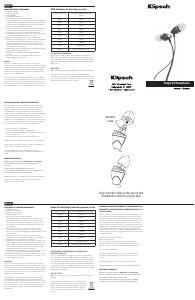

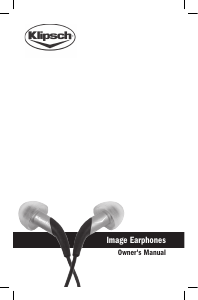
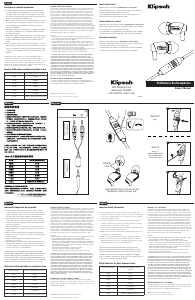
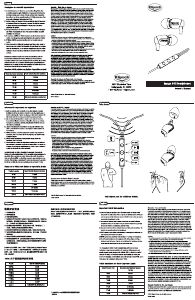
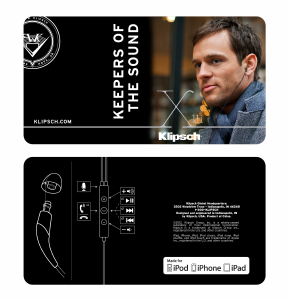
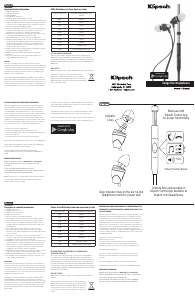
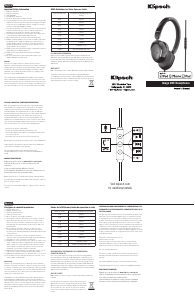
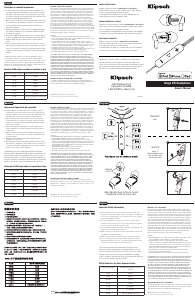
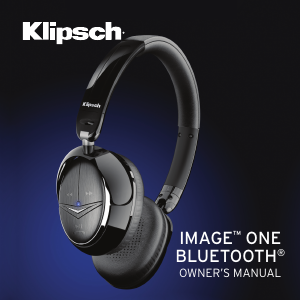
Praat mee over dit product
Laat hier weten wat jij vindt van de Klipsch S4 (II) Koptelefoon. Als je een vraag hebt, lees dan eerst zorgvuldig de handleiding door. Een handleiding aanvragen kan via ons contactformulier.